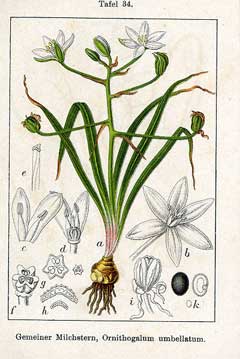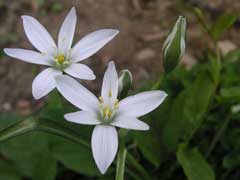 |
|
biolib.de |
 |
| http://commons.wikimedia.org/wiki/User:Liuthalas |
Translate this page:
Summary
Bloom Color: White. Main Bloom Time: Early summer, Late spring. Form: Upright or erect.
Physical Characteristics

 Ornithogalum umbellatum is a BULB growing to 0.3 m (1ft) by 0.2 m (0ft 8in) at a fast rate.
Ornithogalum umbellatum is a BULB growing to 0.3 m (1ft) by 0.2 m (0ft 8in) at a fast rate.
See above for USDA hardiness. It is hardy to UK zone 5. It is in flower from April to May, and the seeds ripen from June to July. The species is hermaphrodite (has both male and female organs) and is pollinated by Insects. The plant is self-fertile.
Suitable for: light (sandy), medium (loamy) and heavy (clay) soils. Suitable pH: mildly acid, neutral and basic (mildly alkaline) soils. It can grow in semi-shade (light woodland) or no shade. It prefers moist soil.
UK Hardiness Map
US Hardiness Map
Synonyms
Plant Habitats
Meadow; Cultivated Beds;
Edible Uses
Edible Parts: Flowers Root
Edible Uses:
Bulb - raw or cooked[2, 5, 46, 61, 183]. The bulbs can be dried and ground into a powder[207]. Whilst the bulbs are palatable and wholesome according to some reports[2, 4, 115], some caution is advised. See the notes above on toxicity. Flowers - baked in bread[183].
References More on Edible Uses
Medicinal Uses
Plants For A Future can not take any responsibility for any adverse effects from the use of plants. Always seek advice from a professional before using a plant medicinally.
Bach
A homeopathic remedy is made from the bulbs[4]. It is useful in the treatment of certain forms of cancer[4]. The plant is used in Bach flower remedies - the keywords for prescribing it are 'After effect of shock, mental or physical'[209]. It is also one of the five ingredients in the 'Rescue remedy'[209].
References More on Medicinal Uses
The Bookshop: Edible Plant Books
Our Latest books on Perennial Plants For Food Forests and Permaculture Gardens in paperback or digital formats.

Edible Tropical Plants
Food Forest Plants for Hotter Conditions: 250+ Plants For Tropical Food Forests & Permaculture Gardens.
More

Edible Temperate Plants
Plants for Your Food Forest: 500 Plants for Temperate Food Forests & Permaculture Gardens.
More

More Books
PFAF have eight books available in paperback and digital formats. Browse the shop for more information.
Shop Now
Other Uses
References More on Other Uses
Cultivation details
Landscape Uses:Border, Container, Woodland garden. An easily grown plant, succeeding in an ordinary garden soil[1, 42]. Tolerates partial shade[200]. Hardy to about -20°c[200]. The dormant bulbs are very hardy and will withstand soil temperatures down to at least -10°c[214]. A very ornamental plant[1], but it can be invasive where conditions suit it[200]. It can be naturalized in short turf or thin grass below shrubs[200], though this should not be mown from the time the bulbs start to grow until they have set seed and the leaves are dying down. Special Features:Not North American native, Invasive, Naturalizing, Suitable for cut flowers.
References Carbon Farming Information and Carbon Sequestration Information
Temperature Converter
Type a value in the Celsius field to convert the value to Fahrenheit:
Fahrenheit:
The PFAF Bookshop
Plants For A Future have a number of books available in paperback and digital form. Book titles include Edible Plants, Edible Perennials, Edible Trees,Edible Shrubs, Woodland Gardening, and Temperate Food Forest Plants. Our new book is Food Forest Plants For Hotter Conditions (Tropical and Sub-Tropical).
Shop Now
Plant Propagation
Seed - best sown as soon as it is ripe in a cold frame[200]. Sow the seed thinly and leave the seedlings undisturbed in the pots for their first dormancy, but apply liquid feed at intervals, especially in their second year of growth. Divide the bulbs at the end of their second year of growth, putting 2 - 3 bulbs in each pot. Grow them on for one more year and them plant them out into their permanent positions whilst they are dormant. The seed can also be sown in a cold frame in early spring. Division of offsets in September/October[200]. The larger bulbs can be replanted immediately into their permanent positions. It is best to pot up the smaller bulbs and grow them on for a year before planting them out when dormant in late summer.
Other Names
If available other names are mentioned here
Native Range
TEMPERATE ASIA: Cyprus, Turkey EUROPE: Austria, Belgium, Switzerland, Hungary, Netherlands, Ukraine, Former Yugoslavia, Albania, Bulgaria, Greece, Italy (incl. Sardinia, Sicily), Romania, Spain (incl. Baleares), France (incl. Corsica), Portugal AFRICA: Algeria, Morocco
Weed Potential
Right plant wrong place. We are currently updating this section.
Please note that a plant may be invasive in one area but may not in your area so it's worth checking.
Conservation Status
IUCN Red List of Threatened Plants Status :

Growth: S = slow M = medium F = fast. Soil: L = light (sandy) M = medium H = heavy (clay). pH: A = acid N = neutral B = basic (alkaline). Shade: F = full shade S = semi-shade N = no shade. Moisture: D = dry M = Moist We = wet Wa = water.
Now available:
Food Forest Plants for Mediterranean Conditions
350+ Perennial Plants For Mediterranean and Drier Food Forests and Permaculture Gardens.
[Paperback and eBook]
This is the third in Plants For A Future's series of plant guides for food forests tailored to
specific climate zones. Following volumes on temperate and tropical ecosystems, this book focuses
on species suited to Mediterranean conditions—regions with hot, dry summers and cool, wet winters,
often facing the added challenge of climate change.
Read More
Expert comment
Author
L.
Botanical References
17200
Links / References
For a list of references used on this page please go here
Readers comment